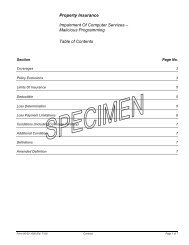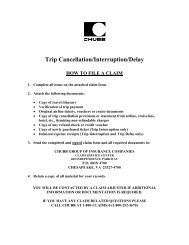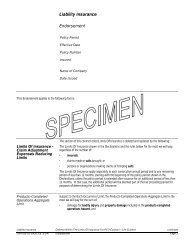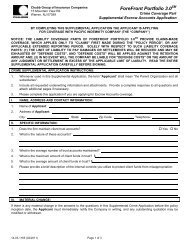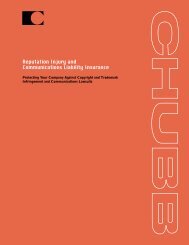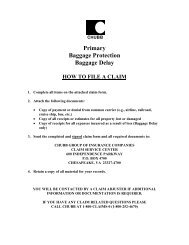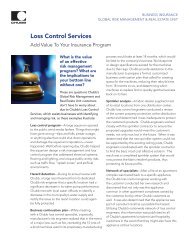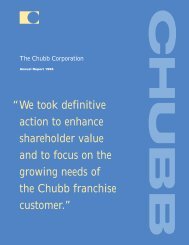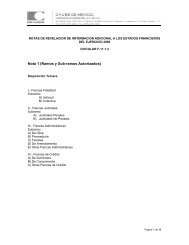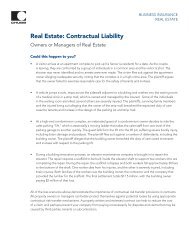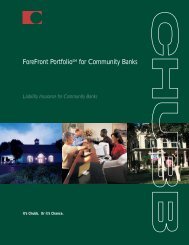Annual Report 2005 - Chubb Group of Insurance Companies
Annual Report 2005 - Chubb Group of Insurance Companies
Annual Report 2005 - Chubb Group of Insurance Companies
You also want an ePaper? Increase the reach of your titles
YUMPU automatically turns print PDFs into web optimized ePapers that Google loves.
On an after-tax basis, property and casualty investment income increased by 11% in <strong>2005</strong> and 13%<br />
in 2004. Management uses property and casualty investment income after-tax, a non-GAAP Ñnancial<br />
measure, to evaluate its investment performance because it reÖects the impact <strong>of</strong> any change in the<br />
proportion <strong>of</strong> the investment portfolio invested in tax-exempt securities and is therefore more<br />
meaningful for analysis purposes than investment income before income tax.<br />
Other Charges<br />
Other charges include miscellaneous income and expenses <strong>of</strong> the property and casualty<br />
subsidiaries.<br />
Other charges in 2003 included expenses <strong>of</strong> $18 million related to the restructuring <strong>of</strong> our<br />
operations in Continental Europe. The restructuring costs consisted primarily <strong>of</strong> severance costs<br />
related to branch closings and work force reductions.<br />
CHUBB FINANCIAL SOLUTIONS<br />
<strong>Chubb</strong> Financial Solutions (CFS) was organized in 2000 to develop and provide customized<br />
products to address speciÑc Ñnancial needs <strong>of</strong> corporate clients. CFS operated through both the capital<br />
and insurance markets. The insurance and reinsurance solutions were written by our property and<br />
casualty subsidiaries, and the results <strong>of</strong> such business are included within our underwriting results.<br />
In April 2003, the Corporation announced its intention to exit CFS's non-insurance business and to<br />
run-oÅ the existing Ñnancial products portfolio. Since that date, our objective has been to exit this<br />
business as quickly as possible while minimizing the potential <strong>of</strong> a large payment due to an unexpected<br />
credit event.<br />
CFS's non-insurance business was primarily structured credit derivatives, principally as a<br />
counterparty in portfolio credit default swap contracts. The Corporation guaranteed all <strong>of</strong> these<br />
obligations.<br />
In a typical portfolio credit default swap, CFS participated in the senior layer <strong>of</strong> a structure<br />
designed to replicate the performance <strong>of</strong> a portfolio <strong>of</strong> corporate or asset-backed securities. The<br />
structure <strong>of</strong> these portfolio credit default swaps generally requires CFS to make payment to<br />
counterparties to the extent cumulative losses, related to numerous credit events, exceed a speciÑed<br />
threshold. The risk below that threshold, referred to as subordination, is assumed by other parties with<br />
the primary risk layer sometimes retained by the buyer. Credit events generally arise when one <strong>of</strong> the<br />
referenced entities within a portfolio becomes bankrupt, undergoes a debt restructuring or fails to<br />
make timely interest or principal payments.<br />
Portfolio credit default swaps are derivatives and are carried in the Ñnancial statements at<br />
estimated fair value, which represents management's best estimate <strong>of</strong> the cost to exit our positions.<br />
Credit default swaps tend to be unique transactions and there is no market for trading such exposures.<br />
To estimate the fair value <strong>of</strong> the obligation in each credit default swap, we use internal valuation<br />
models that are similar to external valuation models.<br />
The fair value <strong>of</strong> our credit default swaps is subject to Öuctuations arising from, among other<br />
factors, changes in credit spreads, the Ñnancial ratings <strong>of</strong> referenced asset-backed securities, actual<br />
credit events reducing subordination, credit correlation within a portfolio, anticipated recovery rates<br />
related to potential defaults and changes in interest rates. Changes in fair value are included in income<br />
in the period <strong>of</strong> the change. Thus, CFS's results have been subject to volatility.<br />
The non-insurance business <strong>of</strong> CFS produced a loss before taxes <strong>of</strong> $6 million in <strong>2005</strong> compared<br />
with losses <strong>of</strong> $17 million in 2004 and $127 million in 2003.<br />
The substantial loss in 2003 was due to downgrades in the Ñnancial ratings <strong>of</strong> certain referenced<br />
securities underlying two <strong>of</strong> our asset-backed portfolio credit default swaps. In the Ñrst nine months <strong>of</strong><br />
48



